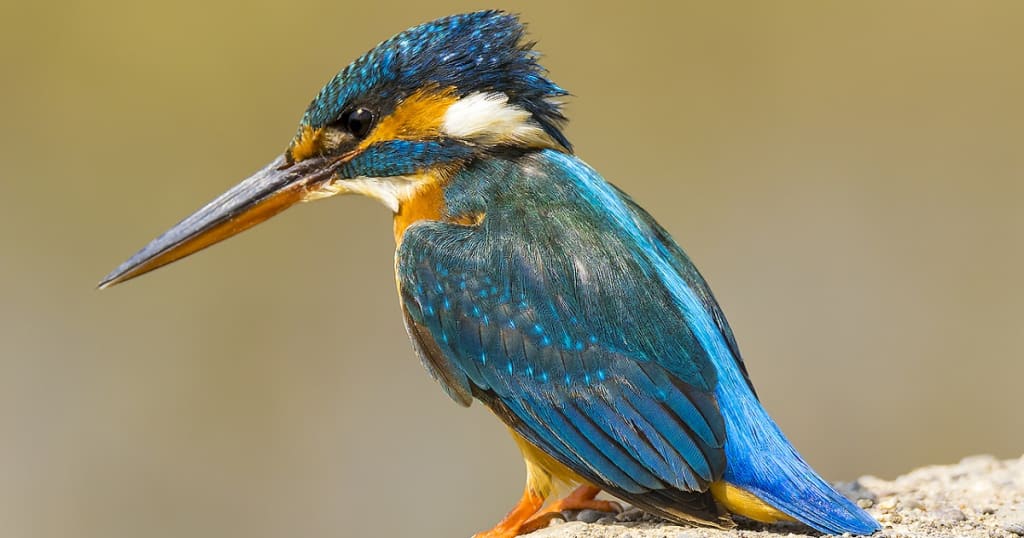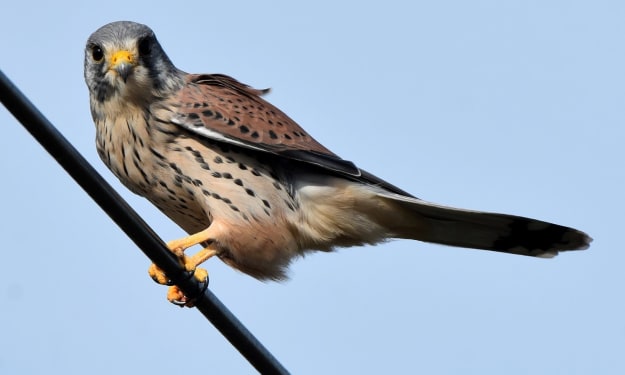
A kingfisher at work by a river or canal is an unforgettable sight. A sudden flash of iridescent blue is followed by a small splash and then, almost immediately, its upward flight to a perch where the prey is stunned, turned head first and then swallowed. One can watch a kingfisher all day and never get bored!
Appearance and behaviour
The kingfisher (Alcedo atthis) is a small bird at 16-17 centimetres in length, of which 4 centimetres is the dagger-shaped bill. It has a large head, a short tail and broad rounded wings. The underside is orange and the upperparts bright blue. The wings are green with blue flecks, which is the same colour as the head, except for orange cheeks and white throat and neck patches. Males and females have similar plumage, but can be distinguished by the male having an all-black bill while that of the female has a red base to the underside.
Kingfishers fly fast and straight, often low above the water with the wings beating rapidly with a whirring noise. It will sometimes fish by hovering for a few seconds, with the head perfectly still, before diving.
The call is a sharp “shree” or sometimes a double “shee-kee”. The kingfisher is often heard before it is seen. A recording of the kingfisher’s call, as well as a video of a kingfisher in flight (and other information) is available on this page from the RSPB website.
Breeding
Kingfishers breed near water in lowland areas. Pairing takes place in February or March, with male birds offering gifts of fish to females.
A nest is excavated in a vertical sandy bank. A tunnel, which can be up to three feet long, is dug by both birds. At the end of the tunnel a cavity is excavated in which five to seven eggs are laid in early April. Both birds incubate the eggs for around 20 days.
The young are fed at the nest for up to 27 days. Given that each chick needs between 12 and 18 fish every day, this is a heavy workload for the parent birds. The chicks are fed in rotation with the hungriest chick taking its place at the front of the nest chamber.
The chamber can become fouled with the pellets of bones and fish scales that the young birds regurgitate and which are then trodden into the chamber floor. They excrete towards the tunnel mouth, which also therefore becomes distinctly unsavoury. This is why the parent birds take care to plunge bathe when they emerge from the nest before they start fishing.
After they have fledged, young kingfishers must fend for themselves quickly because the parents will start a second brood with little delay (and a third is possible in a good season). Kingfishers are highly territorial and will chase off even their own young after a few days. This rush to breed again can lead to a high mortality rate among young kingfishers which have not yet learned the skills of how to fish like their parents. A severe winter can also cause a high casualty rate among kingfishers in their first year. However, some young kingfishers will migrate to the coast at such times in order to find food.
Feeding
As might be expected, the main food of kingfishers is fish, with specimens up to three inches long being acceptable. Typical fish species on the menu are minnows, sticklebacks and loaches. An adult kingfisher is likely to be successful with 80% of its dives. However, kingfishers will also take aquatic insects such as dragonfly nymphs and water beetles.
Distribution
The kingfisher is widely distributed across lowland Britain, being most numerous in central and southern England. It is also found throughout Europe. Related species are found in North Africa and Asia. It is a protected species in Great Britain where numbers have recovered after declining up to about 1985. Efforts to clean up rivers and control pollution have made a great difference to the kingfisher population.

About the Creator
John Welford
I am a retired librarian, having spent most of my career in academic and industrial libraries.
I write on a number of subjects and also write stories as a member of the "Hinckley Scribblers".






Comments
There are no comments for this story
Be the first to respond and start the conversation.